The AMD Threadripper 2 CPU Review: The 24-Core 2970WX and 12-Core 2920X Tested
by Ian Cutress on October 29, 2018 9:00 AM ESTHEDT Performance: Web and Legacy Tests
While more the focus of low-end and small form factor systems, web-based benchmarks are notoriously difficult to standardize. Modern web browsers are frequently updated, with no recourse to disable those updates, and as such there is difficulty in keeping a common platform. The fast paced nature of browser development means that version numbers (and performance) can change from week to week. Despite this, web tests are often a good measure of user experience: a lot of what most office work is today revolves around web applications, particularly email and office apps, but also interfaces and development environments. Our web tests include some of the industry standard tests, as well as a few popular but older tests.
We have also included our legacy benchmarks in this section, representing a stack of older code for popular benchmarks.
All of our benchmark results can also be found in our benchmark engine, Bench.
WebXPRT 3: Modern Real-World Web Tasks, including AI
The company behind the XPRT test suites, Principled Technologies, has recently released the latest web-test, and rather than attach a year to the name have just called it ‘3’. This latest test (as we started the suite) has built upon and developed the ethos of previous tests: user interaction, office compute, graph generation, list sorting, HTML5, image manipulation, and even goes as far as some AI testing.
For our benchmark, we run the standard test which goes through the benchmark list seven times and provides a final result. We run this standard test four times, and take an average.
Users can access the WebXPRT test at http://principledtechnologies.com/benchmarkxprt/webxprt/
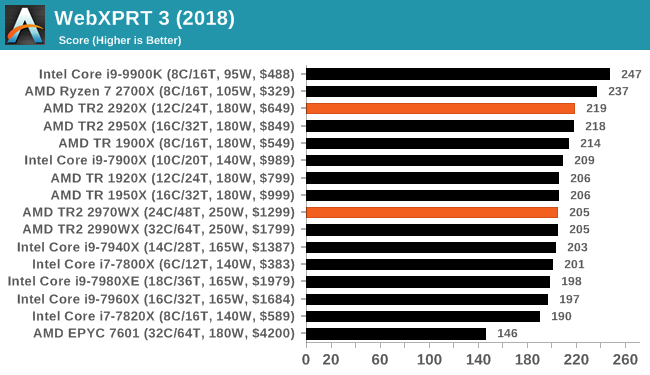
WebXPRT 2015: HTML5 and Javascript Web UX Testing
The older version of WebXPRT is the 2015 edition, which focuses on a slightly different set of web technologies and frameworks that are in use today. This is still a relevant test, especially for users interacting with not-the-latest web applications in the market, of which there are a lot. Web framework development is often very quick but with high turnover, meaning that frameworks are quickly developed, built-upon, used, and then developers move on to the next, and adjusting an application to a new framework is a difficult arduous task, especially with rapid development cycles. This leaves a lot of applications as ‘fixed-in-time’, and relevant to user experience for many years.
Similar to WebXPRT3, the main benchmark is a sectional run repeated seven times, with a final score. We repeat the whole thing four times, and average those final scores.
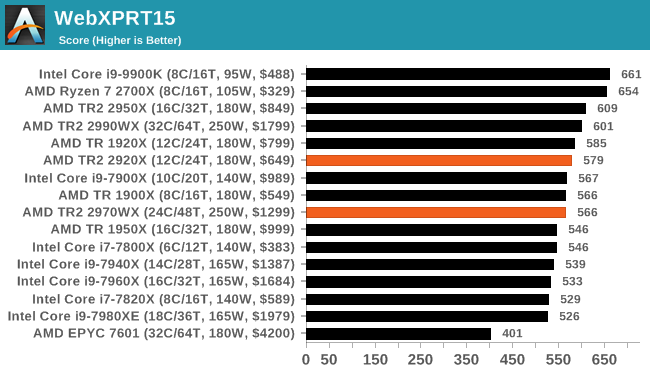
Speedometer 2: JavaScript Frameworks
Our newest web test is Speedometer 2, which is a accrued test over a series of javascript frameworks to do three simple things: built a list, enable each item in the list, and remove the list. All the frameworks implement the same visual cues, but obviously apply them from different coding angles.
Our test goes through the list of frameworks, and produces a final score indicative of ‘rpm’, one of the benchmarks internal metrics. We report this final score.
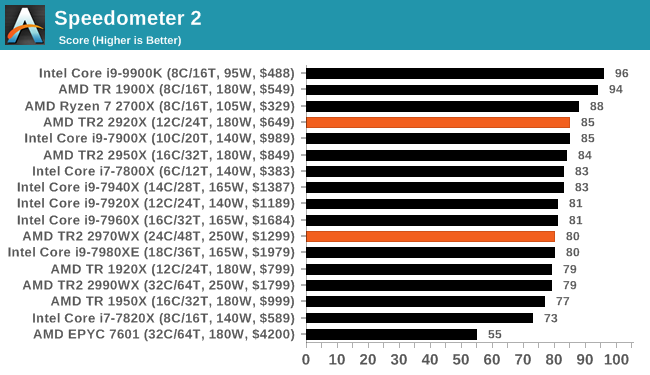
Google Octane 2.0: Core Web Compute
A popular web test for several years, but now no longer being updated, is Octane, developed by Google. Version 2.0 of the test performs the best part of two-dozen compute related tasks, such as regular expressions, cryptography, ray tracing, emulation, and Navier-Stokes physics calculations.
The test gives each sub-test a score and produces a geometric mean of the set as a final result. We run the full benchmark four times, and average the final results.
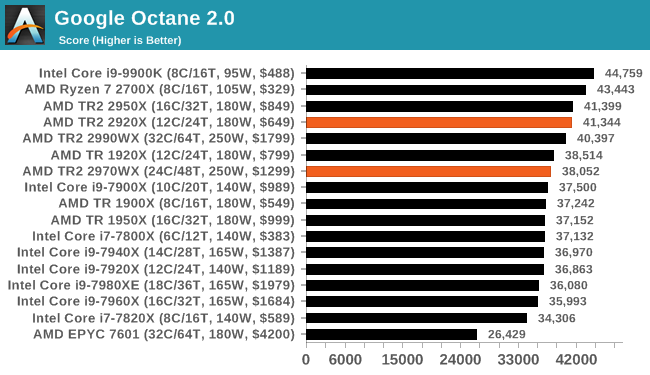
Mozilla Kraken 1.1: Core Web Compute
Even older than Octane is Kraken, this time developed by Mozilla. This is an older test that does similar computational mechanics, such as audio processing or image filtering. Kraken seems to produce a highly variable result depending on the browser version, as it is a test that is keenly optimized for.
The main benchmark runs through each of the sub-tests ten times and produces an average time to completion for each loop, given in milliseconds. We run the full benchmark four times and take an average of the time taken.
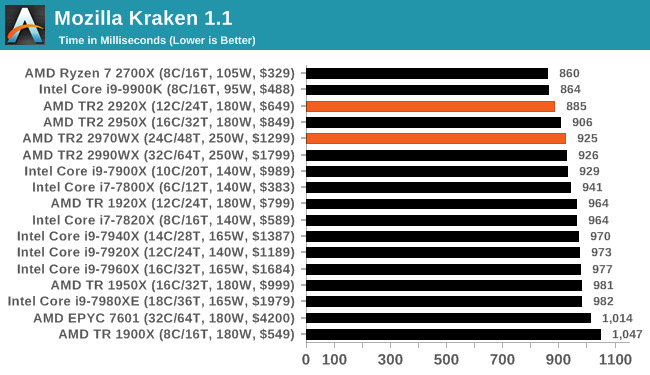
3DPM v1: Naïve Code Variant of 3DPM v2.1
The first legacy test in the suite is the first version of our 3DPM benchmark. This is the ultimate naïve version of the code, as if it was written by scientist with no knowledge of how computer hardware, compilers, or optimization works (which in fact, it was at the start). This represents a large body of scientific simulation out in the wild, where getting the answer is more important than it being fast (getting a result in 4 days is acceptable if it’s correct, rather than sending someone away for a year to learn to code and getting the result in 5 minutes).
In this version, the only real optimization was in the compiler flags (-O2, -fp:fast), compiling it in release mode, and enabling OpenMP in the main compute loops. The loops were not configured for function size, and one of the key slowdowns is false sharing in the cache. It also has long dependency chains based on the random number generation, which leads to relatively poor performance on specific compute microarchitectures.
3DPM v1 can be downloaded with our 3DPM v2 code here: 3DPMv2.1.rar (13.0 MB)
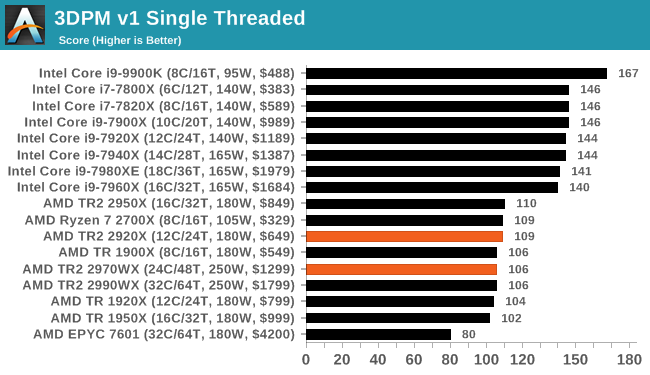
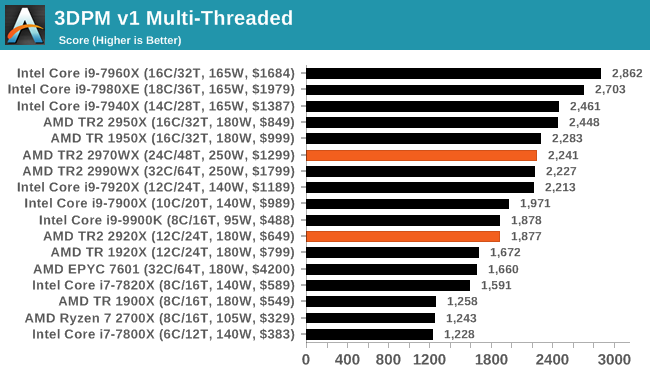
x264 HD 3.0: Older Transcode Test
This transcoding test is super old, and was used by Anand back in the day of Pentium 4 and Athlon II processors. Here a standardized 720p video is transcoded with a two-pass conversion, with the benchmark showing the frames-per-second of each pass. This benchmark is single-threaded, and between some micro-architectures we seem to actually hit an instructions-per-clock wall.
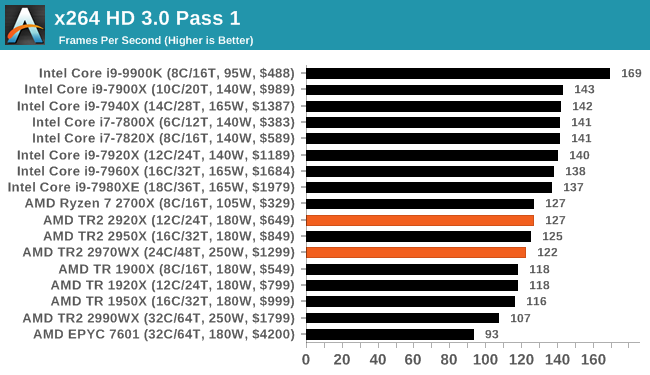
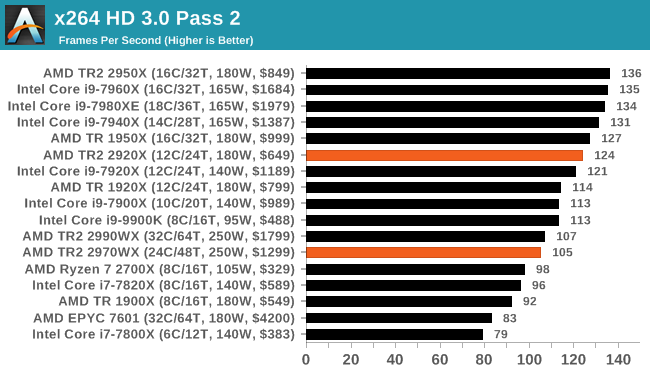










69 Comments
View All Comments
lilmoe - Monday, October 29, 2018 - link
Instead of all the 10+ pages of gaming benchmarks and client side javascript for a platform that most probably won't be used solely for gaming or casual content works, wouldn't it be better to have a suit of server side based benchmarks that are more server oriented? These platforms are becoming very attractive for development and testing of server side applications:- gzip
- pdf conversion
- database transactions
- modern web services
- node.js
etc, etc...
I really see no real value in gaming benchmarks. Not for this platform.
mapesdhs - Monday, October 29, 2018 - link
You might not see the value, but your desire does not reflect that of others, and there's no harm in the data points. You're right though that server side testing would be good, but is this site really the right place for that kind of testing? And from what I've read in the past it can be rather more complicated to run those kinds of tests. AT has a wide audience; they have to think more broadly about to whom they can or should appeal.Howeverm you're wrong in one regard, the cost of the 12-core inparticular to me looks like a rather nice alternative for those wanting decent gaming performance at 1440p or higher, but also good productivity potential. Given its cost, seems like an ideal streaming/gaming/productivity all-rounder to me.
DominionSeraph - Monday, October 29, 2018 - link
i9 9900k would be a better choice. It splits the heavily multithreaded benchmarks with the 12 core, is $160 cheaper for the CPU, and doesn't require a $400 motherboard.eva02langley - Tuesday, October 30, 2018 - link
Techspot takes.''We didn’t have time to retest the Core i9-7900X, but I can assure you with the data we have on hand the 2920X also dominates that part as well, mostly because the 10-core Intel CPU costs over 40% more. That just leaves the 9900K, and honestly, if productivity tasks are the focus then we believe the 2920X is the smarter buy. It will end up costing a little more overall but for applications that utilize the 12-core Threadripper CPU well, a heavily overclocked 9900K will melt trying to keep up.''
TheinsanegamerN - Tuesday, October 30, 2018 - link
The i9 9900k would spend its time melting down under water cooling attempting to keep up, while costing more after the cooling solution then threadripper costs.Icehawk - Monday, October 29, 2018 - link
Please provide your full Handbrake settings (IMO it should be linked in the article), you get about 3x faster encoding than I do at “Fast, Main, 3500kbs”. I’d love to triple my throughput.mapesdhs - Monday, October 29, 2018 - link
It's amazing how some options in Handbrake can cut performane in half. I've been meddling with it a lot today, certain filters can really slow things down.rony_ph - Monday, October 29, 2018 - link
Hello,With all these threadripper tests, how come we never see any reference or use case scenarios for Virtualization. Those CPUs with with this amount of cores, can easily be used to host multiple VMs, etc... yet all the testing is mainly on Office Apps, Gaming and 3D but never on virtualization and the advantage of having such a CPU would do for these scenarios... I'm certain that there are tons of people using those chips to run VMware & Hyper-V, etc...
schujj07 - Monday, October 29, 2018 - link
You wouldn't use these for VMware or Hyper-V to run mission critical VMs. You might use VMware Workstation with them to run Sandbox systems.rony_ph - Monday, October 29, 2018 - link
Never mentioned mission critical systems. As hone or power user. A cpu like 2990w or 2970w will easily let you have 60+ vms running in parallel to do your own testing and lab environment. While buying an equivalent from intel for same price range (not talking about Xeon) wont let u make half as much VMs. You can even probably run an azure stack on it for testing purposes. So the use of such a CPU is huge for an IT Pro for instance.